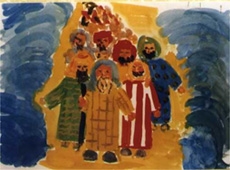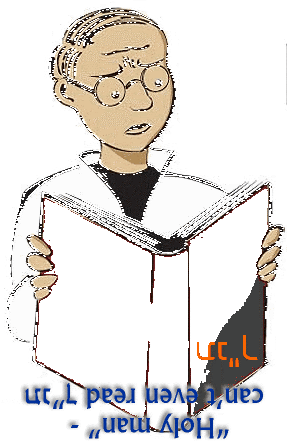
 |
| Torâh | Haphtârâh | Âmar Ribi Yᵊhoshua | Mᵊnorat ha-Maor |
|---|---|---|---|
 |
42.17 — åÇéÆÌàÂñÉó àÉúÈí, àÆì-îÄùÑÀîÈø ùÑÀìÑùÑÆú éÈîÄéí
 |
| Hello? Anyone in there? |
Last year, my daughter was in the "Big Apple" (New York City) and spent several days in the "core" of the "Big Apple"; in the "bowels of the city."
42.17 is the third in a series demonstrating a pattern. The series began in last week's pâ•râsh•âhꞋ. In 40.1ff, we read that Par•ohꞋ confined two of his government ministers of the royal court on the same day. We also note that three days later, Par•ohꞋ decreed his "final judgment" on each of them, one judged innocent and set free, the other judged guilty and executed. In each case, three days of confinement, during which deliberations were conducted, preceded the final judgment.
Similarly, in 42.17, the ten sons of éÄùÒÀøÈàÅì, after having been charged with espionage, a capital offense, were confined for the three days of deliberations culminating in their "final judgment"; after which the final judgment was implemented.
Thus, it is clear that ancient peoples considered a three-day period of deliberations essential to the proper implementation of justice in capital cases. As we have also discussed elsewhere, in ancient times people were considered dead if they didn't respond and no breathing or heartbeat could be detected with one's eyes, ears and hands. This led to the experience (only among commoners in Egypt) of "dead" persons being buried and, when the sepulcher was later opened to bury another relative, evidence discovered that the hapless victim had regained consciousness ("resurrected") and tried, unsuccessfully, to claw his or her way out of the sepulcher. (This only happened among commoners in Egypt because royalty was mummified. No one comes back after mummification.) Over time, it was found that no "resurrection" ever occurred after three days, by which time the condition of a corpse was always clearly beyond "resurrection." Consequently, the practice developed of checking every sepulcher three days after a burial to ensure no "resurrected" person was trapped in the sepulcher trying to get out. On rare occasions, "resurrected" persons were thus liberated from their sepulcher.
The practice of determining the "final verdict" of a buried person after three days led to the development of the practice of deliberating three days before implementing a final judgment in capital cases. Finally, this practice of rulers to deliberate during the three days preceding judgment in capital cases then led to the a posteriori induction that one's final status in the incorporeal world occurred during the three-day waiting period in the sepulcher. Already, it can be seen that, like the Egyptians, ancient peoples sought to map the corporeal realm to the incorporeal realm – and that three days implied a case of capital judgment.
This provides the framework within which to understand one of the most extravagantly supernatural and "miraculous" events in the entire Ta•na"khꞋ: the historical and scientific view—that has never been explained until now—of the three days (!) that Yon•âhꞋ spent in the ãÌÈâ âÌÈãåÉì ("big fish").
 250x114.jpg) |  250x165.jpg) |
Yon•âhꞋ 2.1 records that "åÇéÀîÇï
Next, we read (2.11) that åÇéÌÉàîÆø
Then
We also find out (3.3) that Ni•nᵊweihꞋ, on the east bank of the Tigris River across the river from Mosul (frequently in the news) in northern Iraq, is a three day journey in breadth!!! So, going through Ni•nᵊweihꞋ the first time meant that he had already spent three days and three nights in the "bowels" of Ni•nᵊweihꞋ!!! According to Encarta '95 (Nineveh), the archeological ruins are about 12 km (7.5 mi.) in circumference. However, scholars have noted that, like other ancient big cities, Ni•nᵊweihꞋ consisted of a cluster of cities with their outposts and stations encompassing a much larger area of "Greater Ni•nᵊweihꞋ."
Here's the punch line: "the cuneiform for Ni•nᵊweihꞋ (Nina) is a fish inside a house" (Nineveh, Ency. Jud., 12.1168). Yon•âhꞋ did, indeed, spend three days and three nights in the "bowels" of the ãÌÈâ âÌÈãåÉì ("big fish"); just as my daughter spent several days in the "core" of the "Big Apple"—historically and scientifically true!!! Moreover,
The ones who are wrong are the ignorant who are addicted to supernatural magic—prohibited in úÌåÉøÈä. A miracle is something we don't know how to explain, NOT something that controverts the Perfect laws that
To contradict the Order of a Perfect Creator necessarily implies that the Order – and, therefore, its Author, the Creator – is imperfect. Further, the need for a creator to contradict himself to accomplish his will implies a no-god – and those who follow a no-god are idolaters.
 |
To paraphrase 42.36: "We're running out of food and about to starve. I've lost my son Yo•seiphꞋ, I've lost my son Shim•onꞋ, and now I'm losing my son Binyamin. Why, oh why, does everything bad happen to me?" Ya•a•qovꞋ commiserates.
Do you ever feel like Ya•a•qovꞋ?
 |
One of the most important principles I learned as a youth—for which Hampden DuBose Academy (HDA) merits credit—was that it's easy to praise the Almighty when you're on a spiritual mountaintop—but our challenge is to praise Him as well in the depth of life's valleys. I'm sure that while Mosh•ëhꞋ was up on Har Sin•aiꞋ he had no problem mustering the Spirit to praise
But what is
 |
| Creeping Hellenism – Moses' "Parting of the Sea"; myth creeping into "Jewish" perspective (by an art-teacher student at Hebrew University Center for Jewish Art) |
The Jewish commentators of the Christian era, increasingly acculturated and infused in the creeping Hellenist mythology around them (e.g., the κητος μεγας pervading the stories of Yon•
 |
True, family tradition, that would later be recorded in Tor•
On the other hand, a Divine Plan is no less operative when you are overwhelmed in one of life's valleys. Yes, you; no matter who you are, what your station in life is, how insignificant, even worthless, you may think you are, or what tragedy or hardship you may be facing. No exception has ever been, nor ever shall be, born. It is here that trust thrusts to the fore; the recognition that, though something can be beyond your capacity to change or control, it's always within your free will to trust. There is a purpose to every person's life, and every person has the opportunity to seize his or her finest, noblest, hour—at the very lowest points in your life!
 |
| "Holy Man" – can't even read |
One of the most abused of life's darkest valleys is the plethora of religious "holy man" entertainers in the guise of preachers and evangelists who profess that they somehow effect god's miracle healing. Many of these predators enjoy astounding fame and success from publicizing a few anecdotal recoveries mixed with generous illusions of contrived "miracle healings."
My own eye-witness experience as a Christian insider at, and well after, such events when I was attending a prominent charismatic church near Orlando, FL is that these illusions are most often contrived not by the shaman, who may often be self-deluded himself or herself, but by the victims themselves. The victims, having an escapist need for a miracle healing, a flame fanned by the shaman, are over-eager to prove their "faith" that they're healed, in order to be healed. Consequently, to admit they're not healed constitutes an admission that they lack faith. So, in order to maintain faith, they force themselves to remain in denial that they weren't healed; sometimes worsening their condition. A case in point is a person whose sight is "healed," and discards their glasses. They prefer to see as blurry as before rather than put their glasses back on and admit they weren't healed – because (according to their beliefs) they demonstrate lack of faith by putting on their glasses again. So the shaman tallies a "healing." In fact, later witness consistently demonstrates that, in fact, there are no more genuine "healings" in such groups than anecdotal recoveries statistically found in any other group.
 |
Exacerbating the situation, when these "healed" victims can no longer deny the obvious persistence of their symptoms this is always explained as "losing their healing" due to a "lapse" of their "faith." Now guilt is added to their woes. The net effect of the charlatans is to worsen their victims' plight.
 |
To put it differently, however, they are only as healed as the shaman can delude victims to profess they are, and only for as long as victims are willing to deny their maladies in order to delude themselves, they are healed. Theirs is a pretend world built on delusion and illusion' the same world built on delusion and illusion of a pretend "spiritual Israel" displacing úÌåÉøÈä and the Jews.
Many readers would probably be surprised to learn that such anecdotal "miracle healings" occur just as frequently among Jews, Muslims, Hindus, Buddhists and other religions as among Christians. However, preferring fairytale dreams to the real world, which they view as overwhelming, many victims of illness are suckered into swallowing the immediate 'miracle' solution dangled by these shamans. This is compounded for Christians by mistranslations in the NT of originally Hebrew concepts (see "•
In their evasion of reality, the naive victims are further victimized, being cheated of their opportunity to convert their darkest hour into their finest hour (whether physical recovery follows or not isn't the critical factor). They only extend their darkest hour, indefinitely; enjoying no greater likelihood of physical recovery than the statistical expectation they would have had anyway, squandering their money pursuing magical 'miracles' instead of real miracles, and missing entirely their opportunity to achieve one of their finest hours. Their victimization is invariably expensive (even though typically indirect), exacerbating their plight: trading something free they couldn't ever lose otherwise, for something that victimizes them financially and which they cannot take with them when they leave this life either.
The decision to trust is always exclusively within your grasp. It's free. You don't have to send money to find out if you won, for special "consultations" or prayers from people whose prayers are defined in Mi•shᵊl•eiꞋ Shᵊlom•oh′ 28.9.
 |
When you hear yourself commiserating—singing the blues—or catch yourself feeling blue, depressed, despondent, discouraged or facing illness or other tragedy, that's your cue to seize one of your finest hours. Make it one of your eternal trophies which doesn't rust and cannot be taken from you; investing what you cannot keep anyway to obtain that which you cannot lose.
It's when we're in the valleys, not on the mountain tops, that the grit of our character is tested, and our spiritual mettle forged. It's our actions in life's valleys, not on the mountaintops, which forge our spirit and character, which test us and enable us to grow. Strange as it sounds, we must learn to view the throes of discouragement, the worst that life can throw at us, as our greatest challenges, and our greatest opportunities to excel—our finest hour. The darkest hour of our sorrow and discouragement is also the opportunity for our finest hour of praise demonstrating our love for
What do we see that Ya•a•qovꞋ did when he was in one of his darkest moments? Did he sit down and pray for a miracle? Did he recite Tehil•imꞋ (which hadn't been written yet), commiserate and feel sorry for himself?
Ya•a•qovꞋ trusted
That isn't the solution. With only coincidental, and statistically expected, anecdotal exceptions it doesn't work. What works is to plod. At any given time, you only need to take one step, the next step. If you do that long enough, plodding, you'll succeed. With few exceptions, successful people all echo the same testimony: you must try again however many times you fail, and successful people try and fail countless times just like you, plus one more try until it doesn't fail!!! Each experience becomes a lesson in what you can overcome, each overcoming one step closer to succeeding. The results of Ya•a•qovꞋ's decision are well known. However, his navigation through one of his darkest, and finest, hours is the less traveled path.
 |
42.5-6— This is one of the pᵊsuq•imꞋ from which the principle of a min•yânꞋ (quorum of adult male úÌåÉøÈä-observant Jews) derives. How? In wa-Yi•qᵊr•âꞋ 22.32 it is written, "I will be made holy among áÌÀðÅé éÄùÒÀøÈàÅì. And what are the minimum number of
Yo•seiphꞋ, who was in Mi•tzᵊr•ayꞋim, wasn't there to be counted among the brothers. Binyamin was at home with Ya•a•qovꞋ. So the brothers calling themselves áÌÀðÅé éÄùÒÀøÈàÅì numbered ten. (Of course, the number of tribes lost was also ten.)
 |
 Yoseiph vizier Kheper ka Re Sen-Wosret (Sesostris) I Cairo Museum 250x267.jpg) |
The story of Yo•seiphꞋ is the story of the paragon Gâl•utꞋ Jew. Yo•seiphꞋ is the ultimate image of assimilation. He was so successful in Mi•tzᵊr•ayꞋim that he became second only to Par•ohꞋ. When he was chauffeured by, people on the street bowed as he passed. Yo•seiphꞋ wore the Par•ohꞋ's signet ring of authority. Yo•seiphꞋ earlier had been imprisoned rather than have an affair with the wife of his master, Po•ti•pharꞋ.
Po•ti•pharꞋ, or Poti Phera (41.45), was a member of Par•ohꞋ's royal court and a (pagan) priest of the sun-god (Egyptian On = "sun"), in charge of the country's butchers (the Egyptian counterpart of ka•shᵊr•utꞋ). Po•ti•pharꞋ appears in Egyptian sources as Pa-di-pa-ra, "He whom Ra had given." Ra was the name of the sun-god. It seems apparent that Yo•seiphꞋ's marriage, arranged by Par•ohꞋ, served to clear Yo•seiphꞋ of the charges of adultery with his former master's wife (for which he had been imprisoned) as well as to show that his former master no longer considered Yo•seiphꞋ, now his son-in-law, as a slave.
Yet, how do we reconcile that Yo•seiphꞋ married a non-Jewess, the daughter of a pagan priest? His wife's name in Egyptian meant "she belongs to the god-dess Nat." Does this passage justify intermarriage for Jews in the Gâl•utꞋ?
Midrashic sources fancy that Yo•seiphꞋs wife was only the daughter of Po•ti•pharꞋ by adoption and, beyond that, to convince us that she was really Dinah, who had been raped by ShᵊkhëmꞋ and sent away from the house of Ya•a•qovꞋ. Such extreme axe-grinding isn't satisfying to the serious scholar and only serves to, justifiably, make young Jews smirk and walk away.
AsᵊnatꞋ is the mother of Mᵊnash•
Several things must be recognized.
 154x190.jpg) |
| Ca. B.C.E. 1899 – |
This occurs before the giving of úÌåÉøÈä on Har Sin•aiꞋ. Indeed, many aspects of úÌåÉøÈä were still in flux and development, deriving from the experience of Yo•seiphꞋ, the Israelis in Mi•tzᵊr•ayꞋim, and later Mosh•ëhꞋ.
Yo•seiphꞋ did not choose to be in the Gâl•utꞋ. He was sent there against his will and remained there because he was detained, because he was not welcome among his brothers, and because a famine prevented him from moving back.
Yo•seiphꞋ was chosen for his savior role through no design of his own. Like Ribi Yᵊho•shuꞋa, he did not volunteer to be a martyr or self-sacrifice. From the time he was sold into slavery until he achieved recognition and power from Par•ohꞋ, Yo•
Yo•seiphꞋ did not choose to marry the non-Jewess. Par•ohꞋ imposed it (to force Po•ti•pharꞋ, Yo•
As apparent from his last words, his heart was always on returning to
In the time of Yo•seiphꞋ the Ha•lâkh•âhꞋ hadn't been fixed regarding embalming, and in Mi•tzᵊr•ayꞋim it was expected of persons of Yo•seiphꞋ's and Ya•a•qovꞋ's station.
Parallels of Yo•seiphꞋ's life presaging Ribi Yᵊho•shuꞋa the Mâ•shiꞋakh include
the dual—first and second—lives of each,
the lesson of salvation for Benei Yisraeil achieved by Yo•seiphꞋ / Ribi Yᵊho•shuꞋa under circumstances of suffering, and
the temporary forgetting of each by the one he had saved (Yo•seiphꞋ by the cupbearer).
 |
![]()
This week is a classic example illustrating the
In the earliest recorded references to
"History. The origin of the custom of reading a portion of the [Nᵊviy•imꞋ] after the úÌåÉøÈä reading is unknown. The most plausible suggestion (dating from not earlier than the 14th century [C.E.]) is that the custom was instituted during the persecutions by Antiochus Epiphanes, which preceded the Hasmonean revolt. According to this theory, when the reading of the úÌåÉøÈä was proscribed, a substitute was found by reading a corresponding portion from the Nᵊviy•imꞋ [as a mnemonic to remember the úÌåÉøÈä portion]; and the custom was retained after the decree was repealed. [Another theory is] "that it was initiated against the Samaritans, who denied the canonicity of the Nᵊviy•imꞋ (except for Yᵊho•shuꞋa), and later against the [Tzᵊdoq•imꞋ]. The earliest references to the actual reading of a
While the Διαθηκη Καινη (NT) is unreliable for doctrine because of its extensive post-135 C.E. redactions by Hellenist Roman (gentile) idolaters, nevertheless, it predates
Readers of English substitutes of the Bible (relying on men, translators) will be baffled trying to find a relationship between this week's
 |
![]()
In this year's Dᵊvar Tor•âhꞋ (above), we analyzed the story of Yon•âhꞋ and the ãÌÈâ âÌÈãåÉì. This incident is cited by RibꞋi Yᵊho•shuꞋa in NHM![]() 12.40-42: "Like Yon•âhꞋ was in the bowels of the 'Fish' three days and three nights, so Yᵊho•shuꞋa will be in hâ-ÂꞋrëtz three days and three nights." Now that you realize this three days and three nights is associated with deliberations determining a final judgment disposition, you can, for the first time, perfectly understand his next remark: "Men of Ni•nᵊweihꞋ shall take the stand of adjudication-of-Ha•lâkh•âhꞋ with this generation and they will incriminate it—because they made tᵊshuv•âhꞋ at the call of Yon•âhꞋ, and I am greater than Yon•âhꞋ."
12.40-42: "Like Yon•âhꞋ was in the bowels of the 'Fish' three days and three nights, so Yᵊho•shuꞋa will be in hâ-ÂꞋrëtz three days and three nights." Now that you realize this three days and three nights is associated with deliberations determining a final judgment disposition, you can, for the first time, perfectly understand his next remark: "Men of Ni•nᵊweihꞋ shall take the stand of adjudication-of-Ha•lâkh•âhꞋ with this generation and they will incriminate it—because they made tᵊshuv•âhꞋ at the call of Yon•âhꞋ, and I am greater than Yon•âhꞋ."
Earlier (1999 above), we examined the difference between
There are two terms in the earliest, extant source manuscripts that mislead superstitious-oriented Christians because both terms are ambiguously translated in the NT as "heal":
θεραπευω – The reconstructed original Hebrew (see NHM![]() note 10.8.1) would have been èÄôÌÅì
note 10.8.1) would have been èÄôÌÅì
ιαομαι – The reconstructed original Hebrew (see NHM![]() note 8.8.1) would have been øÄôÌÅà
note 8.8.1) would have been øÄôÌÅà
 |
| True |
Both of these terms describe what all ancient physicians tried to do as well as what we see modern physicians try to do everyday – emphasizing caring, therapy and treatment. Being completely healed or cured as a result was a hoped-for and welcome – but not implied – outcome. Neither describes miracle healing.
What RibꞋi Yᵊho•shuꞋa taught was that his true followers, practicing úÌåÉøÈä, would actively care for the sick, the hungry, the homeless, the poor and the helpless—not shamelessly and hypocritically make their own fortune and fame by staging illusions that deceive and profit from the sick, the hungry, the homeless, the poor and the helpless.
 |
| úÌåÉøÈä | Translation | Mid•râshꞋ RibꞋi Yᵊho•shuꞋa (NHM |
NHM |
||||||||
|---|---|---|---|---|---|---|---|---|---|---|---|
| |||||||||||
 |
![]()
![]()
ha-
This was contrary to (human) nature, not supernatural. They understood how ![]() notes to 14.16-21 & 15.32-38).
notes to 14.16-21 & 15.32-38).
And out of all of the great miracles that Eil, may he be blessed, did with éÄùÒÀøÈàÅì, there was the miracle He did with them in the Second Baiyit (i.e. Beit-ha-Mi•qᵊdâshꞋ) when the Greeks (Hellenists) overpowered the Khashmona•imꞋ while they were kings and Kohan•imꞋ and the Greeks contaminated all of the oil that was in the Miqdash.
During the reign of Beit Khashmona•imꞋ, when, with the assistance of
As memorized in tractate ùÑÇáÌÈú, section "ba-meh madliqin 21.2.
(Note: The beginning of this section, which reviews what oils and wick materials are acceptable according to Ha•lâkh•âhꞋ, is recited in the Beit K'neset Tei•mân•iꞋ every Erev Shabat.)
![]()
(Translated so far)
 |
 |